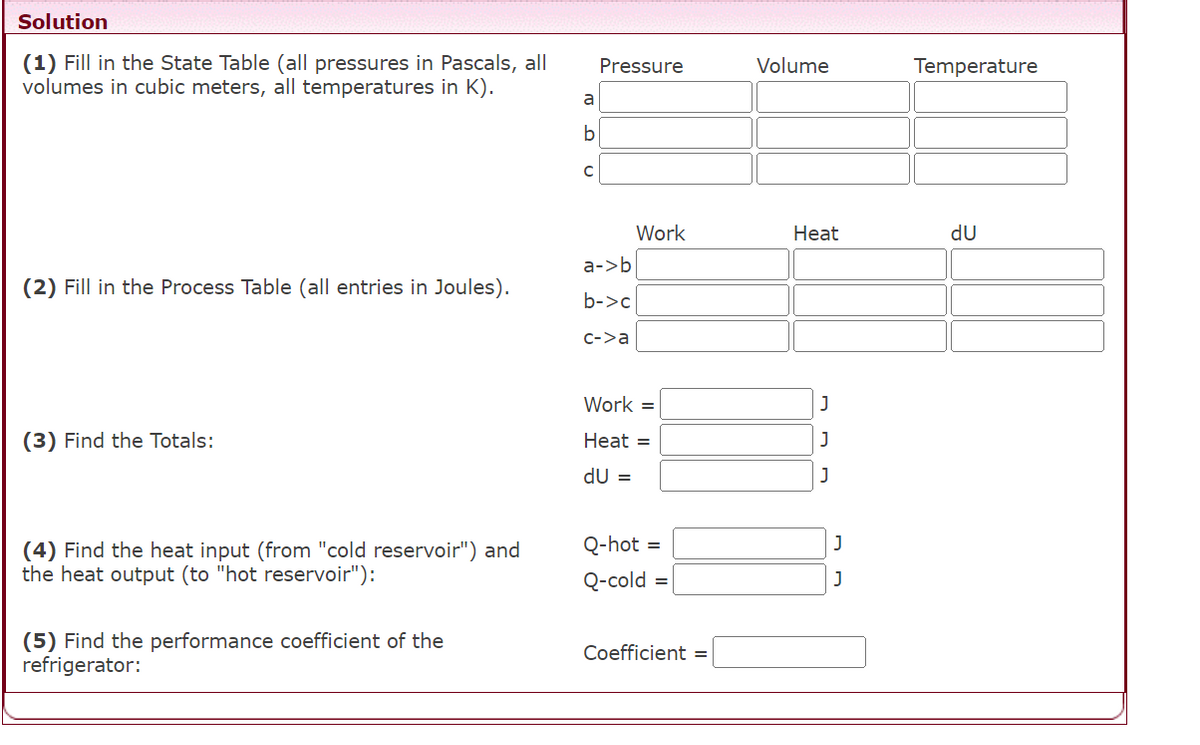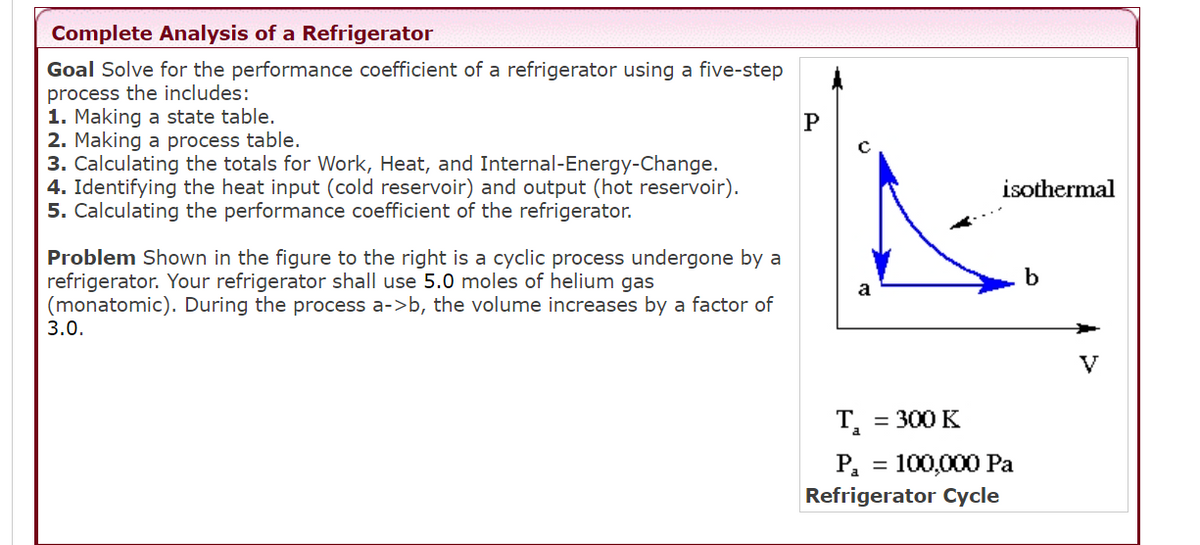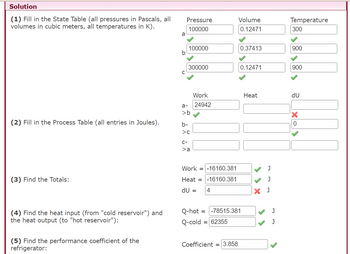Goal Solve for the performance coefficient of a refrigerator using a five-step process the includes: 1. Making a state table. 2. Making a process table. 3. Calculating the totals for Work, Heat, and Internal-Energy-Change. 4. Identifying the heat input (cold reservoir) and output (hot reservoir). 5. Calculating the performance coefficient of the refrigerator. Problem Shown in the figure to the right is a cyclic process undergone by a refrigerator. Your refrigerator shall use 5.0 moles of helium gas (monatomic). During the process a->b, the volume increases by a factor of 3.0.
Goal Solve for the performance coefficient of a refrigerator using a five-step process the includes: 1. Making a state table. 2. Making a process table. 3. Calculating the totals for Work, Heat, and Internal-Energy-Change. 4. Identifying the heat input (cold reservoir) and output (hot reservoir). 5. Calculating the performance coefficient of the refrigerator. Problem Shown in the figure to the right is a cyclic process undergone by a refrigerator. Your refrigerator shall use 5.0 moles of helium gas (monatomic). During the process a->b, the volume increases by a factor of 3.0.
Refrigeration and Air Conditioning Technology (MindTap Course List)
8th Edition
ISBN:9781305578296
Author:John Tomczyk, Eugene Silberstein, Bill Whitman, Bill Johnson
Publisher:John Tomczyk, Eugene Silberstein, Bill Whitman, Bill Johnson
Chapter45: Domestic Refrigerators And Freezers
Section: Chapter Questions
Problem 12RQ: Refrigerators currently being manufactured in the United States are using______as their refrigerant.
Related questions
Question
Goal Solve for the performance coefficient of a refrigerator using a five-step process the includes:
1. Making a state table.
2. Making a process table.
3. Calculating the totals for Work, Heat, and Internal-Energy-Change.
4. Identifying the heat input (cold reservoir) and output (hot reservoir).
5. Calculating the performance coefficient of the refrigerator.
Problem Shown in the figure to the right is a cyclic process undergone by a refrigerator. Your refrigerator shall use 5.0 moles of helium gas (monatomic). During the process a->b, the volume increases by a factor of 3.0.
Solution-
| (1) Fill in the State Table (all pressures in Pascals, all volumes in cubic meters, all temperatures in K). |
|
||||||||||||||||
| (2) Fill in the Process Table (all entries in Joules). |
|
||||||||||||||||
| (3) Find the Totals: |
|
||||||||||||||||
| (4) Find the heat input (from "cold reservoir") and the heat output (to "hot reservoir"): |
|
||||||||||||||||
| (5) Find the performance coefficient of the refrigerator: |
|

Transcribed Image Text:Solution
(1) Fill in the State Table (all pressures in Pascals, all
volumes in cubic meters, all temperatures in K).
(2) Fill in the Process Table (all entries in Joules).
(3) Find the Totals:
(4) Find the heat input (from "cold reservoir") and
the heat output (to "hot reservoir"):
(5) Find the performance coefficient of the
refrigerator:
a
b
с
Pressure
a->b
b->c
c->a
Work
Work =
Heat =
dU =
Q-hot
Q-cold
=
=
Coefficient =
Volume
Heat
J
J
J
J
Temperature
du

Transcribed Image Text:Complete Analysis of a Refrigerator
Goal Solve for the performance coefficient of a refrigerator using a five-step
process the includes:
1. Making a state table.
2. Making a process table.
3. Calculating the totals for Work, Heat, and Internal-Energy-Change.
4. Identifying the heat input (cold reservoir) and output (hot reservoir).
5. Calculating the performance coefficient of the refrigerator.
Problem Shown in the figure to the right is a cyclic process undergone by a
refrigerator. Your refrigerator shall use 5.0 moles of helium gas
(monatomic). During the process a->b, the volume increases by a factor of
3.0.
P
T₂
= 300 K
isothermal
P₁ = 100,000 Pa
Refrigerator Cycle
b
Expert Solution
This question has been solved!
Explore an expertly crafted, step-by-step solution for a thorough understanding of key concepts.
This is a popular solution!
Trending now
This is a popular solution!
Step by step
Solved in 5 steps

Follow-up Questions
Read through expert solutions to related follow-up questions below.
Follow-up Question
Can I get the clear format solution for part 2 table (work, heat, du)
and du for part 3 table

Solution
Knowledge Booster
Learn more about
Need a deep-dive on the concept behind this application? Look no further. Learn more about this topic, mechanical-engineering and related others by exploring similar questions and additional content below.Recommended textbooks for you

Refrigeration and Air Conditioning Technology (Mi…
Mechanical Engineering
ISBN:
9781305578296
Author:
John Tomczyk, Eugene Silberstein, Bill Whitman, Bill Johnson
Publisher:
Cengage Learning

Refrigeration and Air Conditioning Technology (Mi…
Mechanical Engineering
ISBN:
9781305578296
Author:
John Tomczyk, Eugene Silberstein, Bill Whitman, Bill Johnson
Publisher:
Cengage Learning